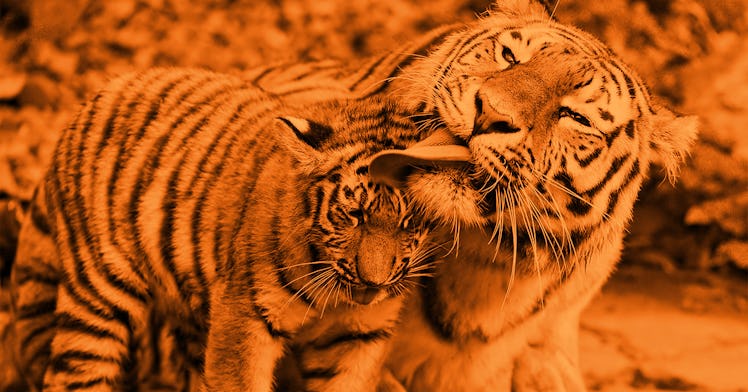How Does An Actual Tiger Mother Parent?
And why didn't anyone write a book about it?

It’s been nearly 6 years since Amy Chua published Battle Hymn of the Tiger Mother, a polemic that fixes touchy-feely, let-special-snowflakes-be-special Western parenting norms with a bone chilling stare and says: “Wimps.” The book’s espousing of the strict discipline favored by a certain kind of Asian parent is as divisive as it is provocative, particularly because things like hundreds of hours of forced piano practice, the denial of goofing off, and warden-like observation of study hours actually leads to more successful adults. Or maybe not. Okay, who knows?
But throughout the controversy, one question remained unanswered: How does an actual tiger … mother?
We asked Dr. John Goodrich, Tiger Program Executive Director for Panthera, the global wild cat conservation organization and, it turns out, there are a few similarities — and a few distinct differences — between Tiger Mothers and their fanged, furry counterparts.
Protectiveness
Tigers are so protective of their cubs that Dr. Goodrich once spent 15 years tracking them in Russia and never actually saw one, save for a few brief glimpses through dense vegetation.
“The primary role of a mother tiger is to protect and provide. She must protect the cubs from a variety of predators, especially the larger ones like bears, wolves and other tigers,” explains Dr. Goodrich. Similarly, Tiger Mothers protect their own cubs from the fearsome jaws of … failure (although they would no doubt kick series bear ass if that became necessary).
Instruction
This is a big point of departure between the 2 species. Both mother tigers and Tiger Mothers are inseparable from their children in the formative years — the first 2 for tiger cubs and, like, the first 25 for humans. So there is some natural learning by observation. “We do know that some other big cats will help their cubs learn to hunt by taking down, but not killing, young prey and giving the cubs the opportunity to practice killing,” Dr Goodrich says, although he admits that no one’s actually seen a tiger do this, because basically no one’s seen a tiger.
Not so with Tiger Moms, who have been observed obsessively training children, which, in a certain parlance could be considered practice in “killing.” As in: “Wow! That little girl just killed Sivan’s transcription of the Liszt b minor sonata for solo violin!”
Gender Roles
It turns out that, in both the human and animal kingdoms, tiger mothers differ sharply with their male counterparts. “Mothers do everything, fathers do nothing,” says Dr. Goodrich. “The interactions between a father and cubs are limited to brief visits (maybe once per month) during which they share a meal that was killed by the mother. However, the father maintains an inviolate territory, protected against other males that would kill the cubs given the chance, so, indirectly, he is watching over them.”
The Tiger Mother’s counterpart is both more involved and less ferocious. “Cat Dads” tend to be the yin to the mother’s yang: chill where mom is intense, gentle where she is firm. Then there’s the other Tiger Mother counterpart — the Wolf Dad. He’s just a dick.
Letting Go
Both human tiger mothers and tiger tiger mothers risk alienating their offspring. “After one year of age, [the cubs] gradually spend less and less time with their mother until they are completely independent,” Dr. Goodrich says. While in mother tigers, this likely comes from a need to reproduce again, intense Tiger Mothers may see it because their kids rebel against such a controlling upbringing. Such was the case for Chua, an event that would cause her to rethink her parenting style.
There are probably plenty of parenting do’s you can learn from both mother tigers and Tiger Mothers. And there are plenty of parenting don’ts you can learn, too. At the end of the day, you’re not a tiger, and you’re not a mother, so it’s probably best not to overthink it.
This article was originally published on